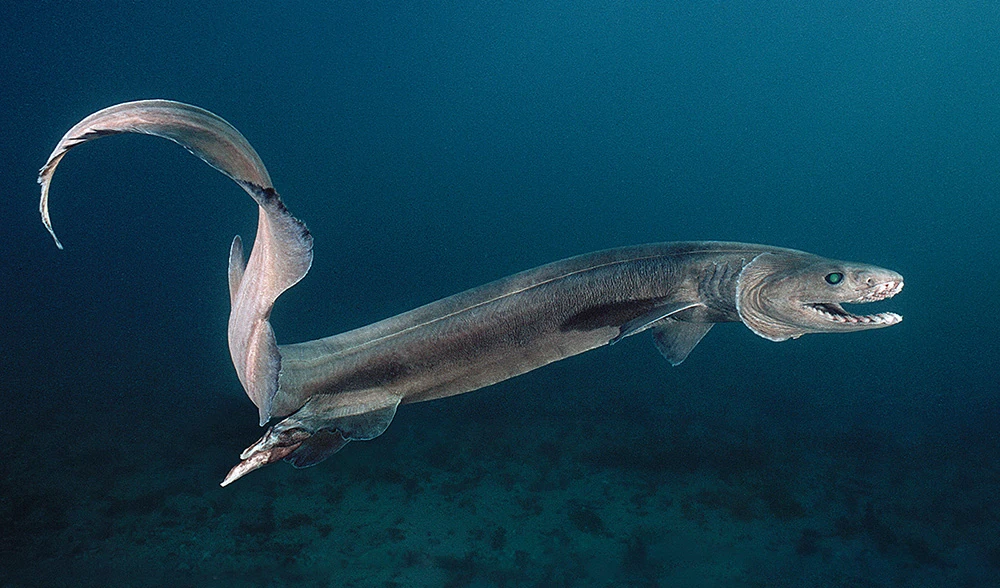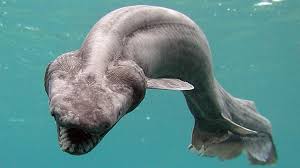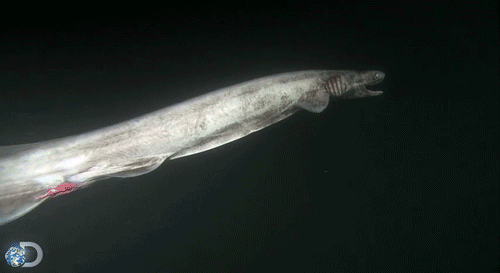
The frilled shark (Chlamydoselachus anguineus), also known as the lizard shark, is one of the two extant species of shark in the family Chlamydoselachidae (the other is the southern African frilled shark (Chlamydoselachus africana)).
The frilled shark is considered a living fossil, because of its primitive, anguilliform (eel-like) physical traits, such as a dark-brown color, amphistyly (the articulation of the jaws to the cranium), and a 2.0 m (6.6 ft)–long body, which has dorsal, pelvic, and anal fins located towards the tail. The common name, frilled shark, derives from the fringed appearance of the six pairs of gill slits at the shark's throat.
The two species of frilled shark are distributed throughout regions of the Atlantic and the Pacific oceans, usually in the waters of the outer continental shelf and of the upper continental slope, where the sharks usually live near the ocean floor, near biologically productive areas of the ecosystem. To live on a diet of cephalopods, smaller sharks, and bony fish, the frilled shark practices diel vertical migration to feed at night at the surface of the ocean. When hunting food, the frilled shark curls its tail against a rock and moves like an eel, bending and lunging to capture and swallow whole prey with its long and flexible jaws, which are equipped with 300 recurved, needle-like teeth.

The zoologist Ludwig Döderlein first identified, described, and classified the frilled shark as a discrete species of shark. After three years (1879–1881) of marine research in Japan, Döderlein took two specimen sharks to Vienna, but lost the taxonomic manuscript of the research.
Three years later, in the Bulletin of the Essex Institute (vol. XVI, 1884) the zoologist Samuel Garman published the first taxonomy of the frilled shark, based upon his observations, measurements, and descriptions of a 1.5-metre (4 ft 11 in)–long female shark from Sagami Bay, Japan.
In the article "An Extraordinary Shark" Garman classified the new species of shark within its own genus and family, and named it Chlamydoselachus anguineus (eel-like shark with frills).
The Graeco–Latin nomenclature of the frilled shark derives from the Greek chlamy (frill) and selachus (shark), and the Latin anguineus (like an eel) besides its common name, the frilled shark also is known as the "lizard shark" and as the "scaffold shark".
The frilled-shark is considered a "living fossil", because its family lineage dates to the Carboniferous period.
Initially, marine scientists considered the frilled shark a living, evolutionary representative of the extinct elasmobranchii subclass of cartilaginous fish (rays, sharks, skates, sawfish), because the shark's body featured primitive anatomic traits, such as long jaws with trident-shaped, multi-cusp teeth; amphistyly, the direct articulation of the jaws to the cranium, at a point behind the eyes; and a quasi-cartilaginous notochord (a proto-spinal-column) composed of indistinct vertebrae.
From that anatomy, Garman proposed that the frilled shark was related to the cladodont sharks of the Cladoselache genus that existed during the Devonian period (419–359 mya) in the Palaeozoic era (541–251 mya).
In contrast to Garman's thesis, the ichthyologist Theodore Gill and the paleontologist Edward Drinker Cope, suggested that the frilled shark's evolutionary tree indicated relation to the Hybodontiformes (hybodonts), which were the dominant species of shark during the Mesozoic era (252–66 mya); and Cope categorized the Chlamydoselachus anguineus species to the fossil genus Xenacanthus that existed from the late Devonian period to the end of the Triassic period of the Mesozoic era.
